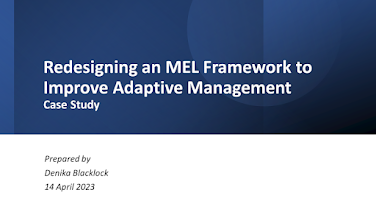Learning by Doing: Developing a Theory of Change for an Adaptive Project
One of the issues that I’m struggling to wrap
my head around is meeting donor requirements while trying to implement an
adaptive project. One the one hand, everyone from the donor to the government
is on board with the approach, although the government is still a bit wary
about the amount of risk they will need to take on in order to see this
approach through to the end. On the other hand, donor templates and guidance
are still very prescriptive, and examples are entirely linear in their approach.
Moreover, examples used in guidance are very concrete (vaccination
interventions seem to be a favourite), unlike the less-defined, system-level
intervention my colleagues and I are working on.
For example, yesterday as I was redrafting the
Theory of Change to our project, I was reminded that the donor had a guidance
note on Logic Models and what the TOC should look like. The problem was that
the guidance note did not apply to complex projects, and it certainly wasn’t
helpful for a project using the adaptive management approach. The proposed
structure of the TOC required all components, from goals down to activities and
investments, to be identified. But when it comes to an adaptive project, should
we have to prescribe outputs and activities for the entire project cycle? Shouldn’t
the focus be on clearly defining the goal of the project, and the outcomes that
serve as the pre-conditions required to achieve, or contribute to, the goal?
Initial activities that help us understand better the current state or status
of the pre-conditions should be our jumping off point to identify possible
pathways forward.
I recognize that this all sounds lovely in
theory, but in practice what the donor says (or needs) goes. How to bridge this
gap? I am of the opinion that leaving the outputs section of the TOC blank to
begin with is critical. It forces us to be less prescriptive (because I’m quite
certain, based on experience, that if we include ‘place holders’ we precondition
ourselves to move the project in one direction when it may need to go in
another). My preferred option at this point is to include an explanatory note
in the TOC for the donor that it will be a truly living document – updated as
one activity is completed, and the next is planned and certain milestones
(outputs?) achieved.
The challenge here is, as always, the
communication you have with your donor – and in many instances that all comes
down to personalities. I’m fortunate in that our counterpart in the donor
organization is willing to try new things and is less focused on the prescribed
guidance that is quickly finding itself out of date, with no replacement soon
forthcoming. But I need to be cognizant of the fact that my counterpart will
change in a few months, and whoever comes next may have different idea, and a
different understanding of what adaptive management means. This means that I
need to be very clear in the monitoring framework about defining key terms and
key processes, on how risk is shared and mitigated, and how decisions on next
steps/identifying pathways are taken. It will provide a basis for our shared
understanding of how the project works in practice, which I hope will mean
little impact on the project implementation. Again, I am reminded that in
practice, adaptive management isn’t about the theory but the communication
between the people implementing the project.

Your concern is shared by many Managers/Evaluators.
ReplyDeleteWe have elaborated the Theory of change applied to Finance for Development taking from our field experience and desk research, actually "filling the dots" of the related narrative and connecting them with our field experience.
In particular, we have assessed the impact of the changes either introduced or endorsed by the Financial Establishment since late 70s last century, focusing on the last decade, which have registered important changes in the rules of the finance game.
The literature dealing with the Theory of Change has deeply discussed the methodological approach in view of evaluating the impact of the related changes. We have evaluated the impact of the changes in the Development Finance Practice linking a recent proposed methodology with the Factors affecting the Project performance , on the grounds that while “filling the dots” there is also a need to evaluate the situation at that point in time, which consent to learn for projecting the future.
Summing up, we have assumed the Theory of Change applied to the Finance for Development as a process of a continuing negotiations among the Development Actors, who have different interests/aspirations/objectives/expectations in pursuing a development goal, which is dominant in the economic development’s theories. In practice this does mean that it is quite impossible to meet all Stakeholders' objectives and the role of the Managers/Evaluators is just to reconcile and get a compromise, but not neglecting the sustainability factor.
You may get more going through THE THEORY OF CHANGE APPLIED TO FINANCE FOR DEVELOPMENT
http://reader.ilmiolibro.kataweb.it/v/1252660/the-theory-of-change-applied-to-finance-for-development_1268103